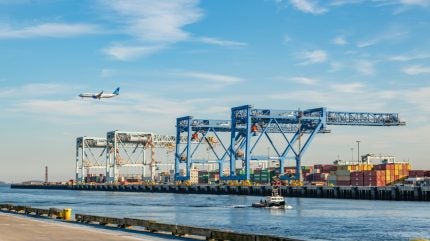
Rising tariffs in the United States are prompting retailers to adjust import strategies as container cargo volumes at major ports are expected to decline for the rest of the year.
The latest Global Port Tracker report from the National Retail Federation (NRF) and Hackett Associates highlights the ongoing impact of trade policy on retail supply chains.

Discover B2B Marketing That Performs
Combine business intelligence and editorial excellence to reach engaged professionals across 36 leading media platforms.
Ports handled 2.36 million Twenty-Foot Equivalent Units (TEU) in July, marking a 20.1% increase from June and a 1.8% rise compared with July 2024. Retailers accelerated shipments ahead of tariff increases, contributing to the high summer peak.
Volumes are projected to fall gradually, with December expected to reach the lowest monthly total since March.
Tariffs reshape retail import planning
The introduction of new tariffs has disrupted traditional import patterns. Reciprocal tariffs on several countries took effect in early August, while an additional 25% tariff on India raised cumulative rates to 50%.
A planned increase in tariffs on China was delayed until November to allow ongoing trade negotiations.

US Tariffs are shifting - will you react or anticipate?
Don’t let policy changes catch you off guard. Stay proactive with real-time data and expert analysis.
By GlobalDataJonathan Gold, NRF Vice President for Supply Chain and Customs Policy, noted that the tariffs are increasing costs for retailers and consumers. “These tariffs and disruptions to the supply chain are adding costs that will ultimately lead to higher prices for American consumers,” he said.
Ben Hackett, Founder of Hackett Associates, added that sector-specific tariffs are influencing the timing and volume of imports, creating uncertainty for retail planning during the crucial holiday season.
Forecast shows retail shipments slowing through year-end
Global Port Tracker projects a decline in container volumes over the final months of 2025.
September is forecast at 2.12 million TEU, down 6.8% year over year, followed by October at 1.95 million TEU, November at 1.74 million TEU, and December at 1.7 million TEU—a 20.1% decrease from December 2024.
The decline reflects both the tariff impact and an early peak season in summer 2025, alongside elevated imports in late 2024 due to port strike concerns.
The first half of 2025 recorded 12.53 million TEU, up 3.6% year over year, while the full-year forecast of 24.7 million TEU represents a 3.4% decrease compared with 2024.
Navigate the shifting tariff landscape with real-time data and market-leading analysis. Request a free demo for GlobalData’s Strategic Intelligence here.




